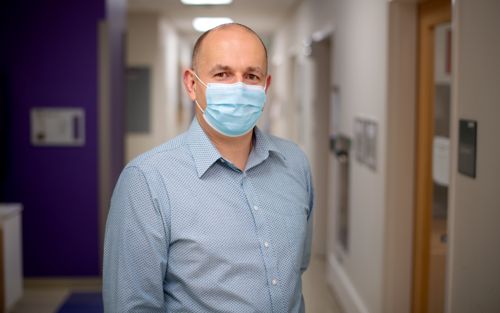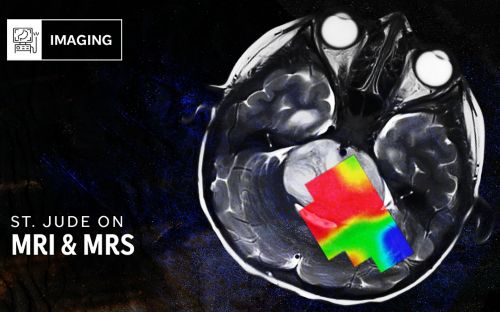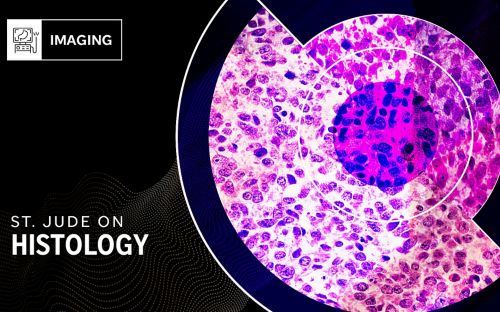St. Jude flu fighters: Researchers tackle influenza virus

St. Jude scientists are studying ways to stop the spread of influenza virus.
As evidenced by the COVID-19 pandemic, predicting, preventing and protecting against pandemic viruses is one of the most difficult tasks for modern public health. Before there was SARS-CoV-2 (the virus that causes COVID-19), the influenza virus was believed the most infectious pandemic threat still circulating around the world, having infected more than 500 million people and causing 50 million deaths worldwide in 1918, with several severe epidemics in the intervening century. Due to influenza’s well-documented history of causing costly international pandemics, preventing the next flu outbreak has been a highly sought-after but extremely challenging goal for scientists and physicians.
St. Jude is one of the institutions leading the charge in high-impact influenza research to reach this goal.
“The average person probably doesn’t recognize that many scientists associate St. Jude with influenza research,” said Richard Webby, PhD, St. Jude Department of Host-Microbe Interactions. “We’re known for our high-quality cancer work, but St. Jude is also a powerhouse for influenza studies. People come to us to learn about the flu.”
St. Jude Center of Excellence for Influenza Research and Response
Influenza researchers at St. Jude have a long history of studying the virus. In fact, St. Jude was one of just six institutions awarded the status of Center of Excellence in Influenza Research and Surveillance (CEIRS) in 2007 from the National Institute of Allergy and Infectious Diseases. More recently renamed the Center of Excellence for Influenza Research and Response (CEIRR), this designation grants funding to, and links, St. Jude researchers to other leaders in the field.
“The CEIRR program connects us to collaborators around the world,” said Webby, who is St. Jude CEIRR co-director. “From Egypt to Bangladesh to Chile, we connect discoveries in the field to basic virology in the lab.” Observations of the virus in the wild flow from the world into St. Jude labs to study, which then inform experiments to better understand and deal with the pathogen.
“By having the Center for Excellence, it gives us the resources to be able to do those high-risk, high-reward experiments that, if they work, will move the field forward and change textbooks,” said Stacey Schultz-Cherry, PhD, St. Jude CEIRR co-director and St. Jude Department of Host-Microbe Interactions member. “We can try novel, untested approaches and ideas, and if these projects work, we can move them forward to develop new basic understanding, technology, assays or therapies.”
Other grant-funding entities want to guarantee a return on their investment as much as possible. Therefore, these organizations avoid funding ambitious projects that very realistically could fail. CEIRR is there to super-charge understanding of influenza, to better treat and prevent this disease by supporting precisely these kinds of projects. Influenza remains a major ongoing threat to public health, especially in children and the elderly, so funding exploratory research is vital to truly reducing its effect on world health.

Richard Webby, PhD, St. Jude CEIRR co-director and St. Jude Department of Host-microbe Interactions member.
“Worldwide, infectious diseases are some of the leading killers of the pediatric population,” said Charles Russell, PhD, St. Jude Department of Host-Microbe Interactions. “Over 90 million children worldwide under five are infected with influenza every year, and a million of those cases are severe. Therefore, understanding these infectious agents and learning how to deal with them is central to the St. Jude mission of safeguarding children’s health.”
Rising to the challenge of treating influenza
St. Jude, partly through CEIRR, is at the forefront of cutting-edge influenza research into new therapeutics and better vaccines. One reason that influenza has frustrated therapeutic development is a direct consequence of its biology.
Influenza is an RNA virus well-known to mutate frequently. Whenever an antiviral is used on influenza, resistant mutants rapidly arise. Unlike antibiotic use in bacteria, where resistance slowly increases over time through generations of human and agricultural use, antiviral resistance can happen within the first patient treated. Recent work from St. Jude found that the ease of nucleotide mutations directs this evolution more than the traditional “survival of the fittest” form of evolution, explaining previously counterintuitive results. The virus’s rapid mutation still generates enough variants to develop antiviral resistance.
The lack of effective antivirals has pushed influenza research towards vaccine development, using the immune system’s robust antiviral response against the virus, as opposed to therapeutics. Still, there are reasons to continue the search for truly effective antivirals.
“When you think about the kids we treat at St. Jude, it’s important to realize they’re highly susceptible to infectious disease and often immunocompromised by their treatments,” Russell said. “The CEIRR program extensively studies whether the circulating viruses are resistant to antiviral drugs or not, and how to best manage antiviral drug treatments too.”
Immunocompromised patients, by definition, do not have a fully functioning immune system. As vaccines work by activating the immune system, the only choice to treat these patients when they are infected is to use antivirals and similar therapeutics. St. Jude is committed to finding and developing interventions that will be effective for these patients.
Once their immune system is reconstituted, vaccines are still the best hope to prevent disease, which is also true in the general population.
Improving the flu vaccine
In addition to fundamental research on influenza viruses, St Jude scientists are also working to improve the flu vaccine through its Collaborative Influenza Innovation Center (CIVIC), which it co-directs with the University of Georgia. The seasonal flu vaccine varies in efficacy every year because the dominant strain of the circulating virus differs from the prior year. Researchers study the strains circulating nine months before the flu season to choose just four that can be included in the annual vaccine. Prediction models are imperfect, meaning that the vaccine is not matched exactly to the circulating strains. Additionally, COVID-19 has changed both how influenza spreads and vaccine strain selection, complicating annual influenza vaccine development.
“Flu numbers were down when the COVID pandemic happened, but now the virus is spreading again,” Russell said. “For the seasonal flu, there’s always been four main strains we vaccinate against. But it appears now that one of the influenza B lineages has disappeared, at least for the time being.”
No one knows the consequences of losing an influenza lineage from circulation. Still, researchers need to decide what to include in the vaccine. St. Jude and the CEIRR program participate in the complicated process of choosing which strains will be incorporated into the vaccine.
In an ideal world, scientists would create a universal, one-shot vaccine that works against all strains. However, all efforts to do so to date have been ineffective.
“Early on, there was a lot of hype that one antigen in one vaccine could protect against all flu strains,” Russell explained. “As the field has evolved, we now have a viewpoint to try to broaden the immunity with the seasonal vaccine.”

Stacey Schultz-Cherry, PhD, St. Jude CEIRR co-director and St. Jude Department of Host-Microbe Interactions member.
The seasonal flu vaccine can take two forms. The injected form includes inactivated virus or viral proteins, while the nasal spray FluMist contains an attenuated “weaker” version of the live virus. The key to triggering an immune reaction in both cases is the influenza hemagglutinin protein.
“Through the Collaborative Influenza Vaccine Innovation Centers (CIVIC) program, we found that with some adjustments to the live attenuated vaccine, including changing flu proteins such as hemagglutinin or modifying the vaccine platform,” Schultz-Cherry said, “We can protect high-risk populations from getting infected.”
The very young and the elderly are the highest-risk groups for the influenza virus. Already, the elderly receive higher doses of the vaccine. Such improvements could save tens of thousands of lives every year. Therefore, the Schultz-Cherry lab focused even more on improving these vaccines in a close collaboration.
“Our collaborator Ted Ross at Cleveland Clinic has developed computational methods to optimize the hemagglutinin protein in the vaccine to drive antibodies that can protect against different variants,” Schultz-Cherry explained. “By using his protein in our vaccine platforms, we found that we not only get good protection in models of these high-risk populations but also that we can protect against different strains of flu.”
This work can potentially improve the seasonal flu vaccine while informing a future universal vaccine. During their research, the scientists also discovered a highly desirable property of one of these rationally designed vaccines.
“We found one that may actually be able to prevent transmission from an infected animal to a non-infected animal,” Schultz-Cherry said. “Imagine if we had something like that during the SARS pandemic, that becomes a game changer.”
CEIRR was designed to identify and take the chance on such big-picture and potentially game-changing ideas for influenza control based on fundamental research. One cornerstone of this fundamental research focuses on the relationship between viral proteins and transmission.
Influenza protein stability affects transmission
Russell’s lab studies the flu hemagglutinin protein for its effect on transmission. His team found that the stability of the protein, which defines its ability to resist the acidic environment in the lungs, impacts infection. To measure this, they collected viruses that were present in the human population, tracking their infection abilities.
“We took circulating viruses and found that some had a hemagglutinin protein that wasn’t very stable, and others had a more stable protein,” Russell said. “And the strains that weren’t as stable lost some of the properties to both grow well and transmit in a ferret model.”

Charles Russell, PhD, St. Jude Department of Host-Microbe Interactions member.
The Russell lab found exact residues on the protein that altered stability. That information may help forecast pandemic potential, as those viruses with more stable hemagglutinin were better able to jump species. This work may further improve seasonal vaccines, creating a virtuous cycle of altering the hemagglutinin protein for better response in the Schultz-Cherry-Ross collaboration.
“The biggest strength of CEIRR is the breadth of the program,” Russell said. “We get these surveillance samples to characterize them, then study the viruses to learn what makes them spread. After that, we try to develop new ways to enhance vaccines or improve anti-influenza drugs.”
Influenza host factors explains why flu infections differ
Not all of these approaches have to do with influenza’s characteristics. Some focus on the human body that hosts the virus and the complex antiviral systems found there. Recent St. Jude work showed other host factors, such as which immune cells are present six months before infection, predict disease severity. Clearly, factors in the human body before the virus arrives strongly influence viral outcomes.
“We’ve been struggling for decades, if not centuries, with why some people get sick with infections and some don’t,” Webby said.
As St. Jude researchers have studied flu, this variance in outcomes could not be explained by the virus alone. Even genetically similar flu viruses would cause different outcomes in patients and models. Schultz-Cherry’s work focuses on how the metabolic health of a host, rather than the virus, explains these disparate outcomes.
“Having a high body mass index (BMI) can impact anything from influenza disease severity to susceptibility to infection,” Schultz-Cherry said. “When we looked at why, we found that even the epithelial cells from people with high BMI are slow at recognizing they are infected.”
Cells from those with a higher BMI appear to take longer to activate the antiviral response by several hours. Given the exponential nature of viral growth, losing these crucial hours has significant consequences for the body. The greater viral load now makes it harder to clear from the body. In addition, the virus can penetrate deeper into the lungs, causing more severe disease.
“It’s like this weird, perfect storm,” Schultz-Cherry explained. “We want to understand what’s causing it. We know some of the most potent antiviral responses are from proteins called interferons that are secreted by cells. We’ve shown these interferons are not being secreted properly in these cells from obese people, but we still don’t know why.”
Interferons are the proteins infected cells use to signal something is wrong and activate the immune system. The delayed ability to produce interferons is an intriguing place to look for the difference between cells from obese and healthy-weight individuals, but the exact mechanism is unclear.
Modern antivirals work even worse in obese mouse models than in identical, fit mice. When the Schultz-Cherry lab does find the molecular mechanisms that underpin why the virus overperforms in those with high BMI, they hope to make therapeutics to protect vulnerable populations better.
Leading the influenza research field against a global threat
Many scientists can trace their academic careers in influenza directly to their time at St. Jude. The same is true for many in governmental research or public health positions who work on flu. Robert Webster, PhD, St. Jude Department of Infectious Diseases emeritus member, began that legacy decades ago by discovering the natural reservoir of influenza virus was in birds, which eventually grew into the CEIRR program.
St. Jude, CEIRR and their collaborators are still spending massive amounts of time and effort to research and understand flu better. Those discoveries will hopefully lead to better vaccines and antivirals. Given the resources dedicated to preventing and treating the disease, it’s clear that the virus is more than “just the flu” — it is an ongoing public health risk.
“Flu-related deaths are the seventh leading cause of death in the United States,” Russell said. “We see an average of 36,000 deaths a year. These viruses continue to spread and are a constant threat. It’s important we continue surveillance to study these viruses, to understand the properties they need to gain the ability to transmit between people and then learn how to make better vaccines or platforms to try to deal with these threats as they emerge.”
While the exact nature of that threat cannot be predicted, one thing can be foreseen: St. Jude influenza experts — and their collaborators across the globe — will be at the forefront of confronting the virus.






